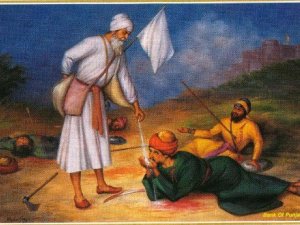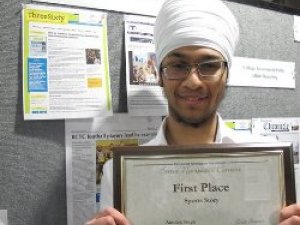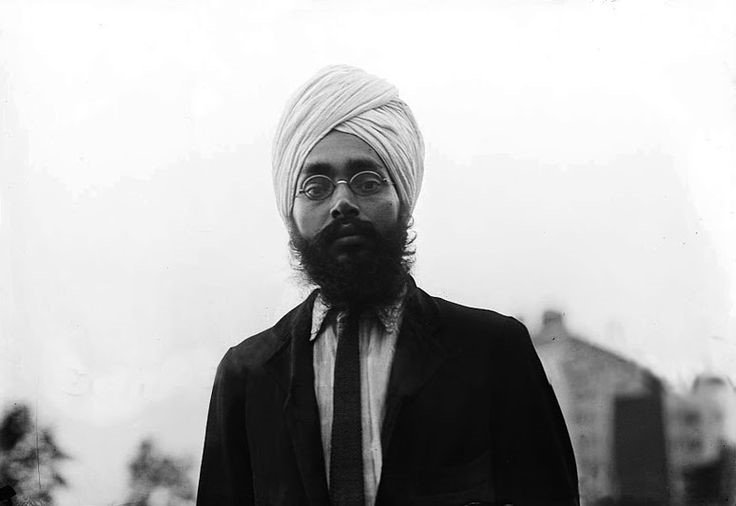
First Nanakian Global Envoy:
A mystic star of cosmos,
Sant Teja Singh Ji
Gursagar Mastuana & Baru Sahib
"In memory of his descending on this earth on May 14, 1887."
seva by Gurdhyan Singh and Amolak Singh
The Fifth Nanak, Sri Guru Arjun Dev Ji Maharaj, eloquently revealed the divine qualities of a Brahamgyani in a very detailed manner in Sri Guru Granth Sahib Ji Maharaj. According to Sache Patshah Ji, Brahamgyani is the highest spiritual stage of a soul that a human being can achieve with the Satguru Ji's Grace. The Guru bestows eternal blessings upon rare souls, and there remains no difference between the Guru and such a soul, who have all of the Guru's divine qualities as the Guru is Akaal Purakh.
The Brahamgyani's mind is rooted in the Guru's Naam, and is always so tranquil that no worldly affairs can distract him from serving the True Guru. The Brahamgyani is inherently humble but always fearless. His humility is reflected in his existence, as he remains at the dust of the feet of the entire universe. This quality of humility comes only with the advent of Naam in one's heart that extinguishes one's fiery ego. When performing ostensibly worldly affairs, the Brahamgyani is actually fulfilling his spiritual obligations. His explanations simply satisfy the curiosity of world around him, but for spiritual seekers he uses parables to make a providential point about mundane affairs.
One such Guru realized personality in the 20th century is Baba Attar Singh Ji Gursagar Mastuana. He had a beloved Sikh, Sant Teja Singh Ji, also Guru blessed, who was born as Niranjan Singh to a religious and blessed mother on May 14, 1877 in Balowali, district Gujwanwala, in Punjab, Pakistan. He belonged to a very well to do family and his father Sardar Rala Singh was a prominent physician.
Sant Teja Singh Ji was formally educated in the Anglo style education, and grew up learning rational thinking. He was honest and kind to others. He had spiritual inclinations but his outlook was filtered through the prism of his rationalist intellect.
Whenever he had spiritual questions or doubts, Sant Teja Singh Ji would visit the nearby Arya Samaj or Brahmo Samaj camps, which were rationalist theological streams within the Sanatan Dharam framework.
As a result, the strong effect of the prevalent anglovedic context rendered him devoid of any substantial reverence, devotion or love for spiritual dimensions of life. He did not inculcate respect for spiritual personalities, especially his own eternal living Guru, Sri Guru Granth Sahib Ji Maharaj or ancient ceremonies and practices according reverence and honor to Sri Guru Maharaji Ji.
The anglovedic conditioning clouded his thinking so much that he even considered bowing and paying respect to exegetes, preachers, kirtani jathas, saints, or even Sri Guru Granth Sahib Ji Maharaj, as idol worship, which he thought was prohibited by Sikh ideals.
Unsurprisingly, he used to 'read' Sri Guru Granth Sahib Ji Maharaj for guidance and understanding while sitting on a chair and with his shoes on. He had numerous doubts about the spiritual dimensions of life and had his own answers that rationalized his thinking for a while, but did not finding lasting, deep answers.
After completing his MA LLB in 1901, Sant Teja Singh Ji started law practice but gave up after a week as it was morally suffocating him. He was then selected for the prestigious civil service through a competitive examination of the British government. Again, he could not continue for long in civil service due to its law enforcement dimension and soon accepted an offer to work as the first Sikh vice principal of Khalsa College, Amritsar in 1903, as education was his passion. In 1905, he became its principal.
As a top educational leader of Khalsa College, he was regularly expected to attend Dharamshal situated within the college's vicinity and pay his respect regularly to Sri Guru Maharaj Ji. Since he was uncomfortable with this, he devised a ruse in which he would visit before anybody else so that his nobody will notice his omission.
The mind indeed can trick the world but not the true Guru. On one blessed day, he had a mystical experience that caused a major paradigm shift in his life and thinking. Despite his adamant attempt to not bow with reverence, with Maharaj Ji's grace and power, he involuntarily fell flat at the lotus feet of Sri Guru Granth Sahib Ji Maharaj, and felt the divine presence of all ten saroops of Sri Guru Maharaj Ji.
This experience shook him completely and he felt a need to talk to someone who could explain the meaning of this experience, and dispel his doubts. Sant Teja Singh Ji immediately went to Baba Sham Singh, the famous kirtania of that time at Sri Harimandir Sahib and a deeply meditative Sikh, with his queries. Baba Sham Singh suggested that Baba Attar Singh Ji Gursagar Mastuana, the repository of Guru Maharaj Ji's divine treasure and grace, was the only divine personality who could dispel his doubts and guide him properly on his journey.
Finally, Sant Teja Singh Ji met Baba Attar Singh Ji, and their first meeting aggravated his longing for something that he was still not fully aware of what it was. Baba Ji administered Khande de Pahul to him along with his family, and gave him the new name Teja Singh, and instructed him to follow rehat strictly including doing naam simaran. Their relationship grew deeper and gradually Sant Teja Singh Ji's doubts, queries and dilemmas were dissipated. The sangat of a Brahamgyani accelerated Sant Ji's spiritual learning, he understood the real meaning and significance of divine aspects of Sri Guru Granth Ji Maharaj, and the Puratan maryada that gives matchless honor, dignity and respect to Sri Guru Granth Sahib Ji Maharaj as the living Guru.
Sant Teja Singh Ji offered himself to Baba Ji with full dedication, and his submission was total, pure, and selfless. Baba Ji was thinking of establishing an educational institution at Gursagar Mastuana, where along with worldly education, spiritual learning would be provided. Baba Attar Singh Ji told Sant Ji that:
"I wish that an educational institution is established where the spiritual science, as advocated by Guru Nanak and the material science of the West are combined together for teaching students so that they may adopt spiritual philosophy in action and become assets to the world."
Baba Ji believed that worldly education is imperative but had to be based on spiritual values such as Sikh ideals. He always maintained "that modern day scientific education without any spiritual value based fortification would be unable to bring peace to mind, body and soul."
In addition, Baba Attar Singh Ji also had a visionary divine mission to sow the seeds of Sikh spirituality in other parts of the world as Sri Guru Nanak Dev Ji vision, particularly in the West. He decided that someone with intellectual capacity, impeccable character, and unflinching spiritual dedication to the Sikhi, only Sant Teja Singh Ji, could perform this task ardently and altruistically. In addition, due to his solid grounding in Naam simaran and seva, Baba Ji knew that he would not go astray or distract from his path, and Baba Ji blessed him with a mission abroad, with the following commandments:
- Keep your entire original form of body and hair intact.
- Don't argue with anyone, and if a situation arises, simply say with folded hands, "What can this humble servant do?"
- Establish Guru Ghar where there is Sikh Sangat.
- Convey the message to the people that the accumulation of Ridhi Sidhi (occult powers) is meaningless, and divine realization is higher.
- Spread the word - Guru Granth Sahib Ji as the Living Guru of the Sikhs.
- Lecture only if one is free from ego. Else, refrain.
Blessed Sant Teja, Singh Ji, first Nanakian global envoy, embarked on an unmatched and ambitious mission to fulfill the divine wishes of Sri Guru Nanak Dev Ji Maharaj as expressed by Baba Attar Singh Ji, and helped people transform and organize for their worldly survival, enhance their spiritual poise and connect them to the Guru.
He left for England on August 6, 1906 and arrived on August 24th. His wife, two children, and four others accompanied him: Bhai Bhagat Singh, Amar Singh of Guru Nanak Bhandar, Dharm Anant Singh, and Hari Singh Basra. He rented a place and immediately arranged to have Sri Guru Granth Sahib Ji's Prakash with reverence in a separate room with full maryada.
In England, he remembered Baba Attar Singh Ji's resolve to reverse the trend made by Sikhs in England, who cut their hair, drowned themselves in alcohol and gave up their turban, the stamp of the Guru. He successfully worked to fulfill Baba Ji's resolve through Amrit Sanchar.
Sant Teja Singh Ji was admitted to Cambridge, and he was the first baptized Sikh to be allowed to participate in campus life while following rehat and wearing his turban in Cambridge's history. Later, he joined Harvard University and received his second Masters' degree in 1911. He also joined University of California-Berkeley and Columbia University.
During his mission, with Satguru Maharaj Ji's grace and cooperation of the sangat, Sant Teja Singh Ji established the first Sikh Dharamshal in the UK, USA, and Canada: London, England in 1910, Stockton, California in 1912, and finally Victoria, British Colombia in 1913.
Sant Ji's capacity to engage with people from all faiths soon made him well known. He was invited to talk about the Nanakian way of life with Indians and non-Indians alike. His public lectures would be attended by thousands.
Sant Teja Singh Ji was also invited to attend the Berlin World Congress of all Religions. All the delegates spoke about the teachings and philosophies of their respective religions. He educated the participants about the divine vision of Sri Guru Nanak Dev Ji Maharaj such as His message of the unity of humankind, and the presence of same divine light within every creature of the cosmos.
He stressed the core spiritual reality that the whole universe has sprung up from the Divine Light and the bodies of people of all religions, races, castes, colors and creeds are made up from five elements i.e., earth, water, air, energy and ether.
According to Gurbani, Sant Teja Singh Ji explained that the artificial sense of thine and mine act as the cloud of ignorance against the Divine Light and becomes a bar to self-realization. Under the influence of lust, greed and ego, the humans engage in the animal instincts, reactions and infighting. He suggested and that the veil of selfishness and egoism can only be removed by immersing ourselves in the Divine Name, whose Divine Light shines in all human hearts and leads to the realization of the One-in-all and all-in-One, ending the duality of mind.
Sant Teja Singh Ji further pointed out that without self-realization of the Divine, there cannot be any permanent peace in the world, for which Sri Guru Nanak Dev Ji Maharaj Ji has shown a simple path.
In 1908, the Canadian government's plan to deport all Indians to Honduras came out. Sant Ji successfully campaigned for the rights of all Indians for their permanent residency rights to stay in Canada, which was an important turnaround in Canadian history.
Sant Teja Singh Ji's activities concerned to the British Empire although his actions were providential rather than political. The following excerpt exemplifies the Empire's concern:
"Captain H.F.E. Freeland of the Punjab regiment, had been in India for 16 years, and had seen services in Burma and China, also. He was in Vancouver in December 1908, and at a party in his honor at Hotel Vancouver, he said that: The vast masses of the people in India are loyal to the British and there will be no general uprising… England's safety comes from the large number of races professing different creeds as well as the caste system… In dealing with Orientals you must act with a firm hand. If you show weakness they will not be slow to take advantage… I have read the seditious utterances of Professor Teja Singh who is said to be the leader of the local colony. The boldness of his utterances surprised me. If he returns to India and talks the same way, I think he would be speedily silenced…"
Sant Teja Singh Ji led a vigorous and motivated campaign for administering Khande de Pahul in North America and brought many fallen and distracted Sikhs back into the Sikhi. Because of his deep spiritual strength born out of his grounding in Naam simran, he was able to bring about profound changes in the minds of the English, Canadians and Americans.
His presentation of Sikh spirituality was so deeply eloquent that many westerners became interested in Sikhism and started participating regularly in Sikh congregations conducted by Sant Teja Singh Ji. With his mystic charisma, many Americans and Canadians became permanent devotees of Sri Guru Nanak Dev Ji Maharaj.
Sant Teja Singh Ji delivered his message in a clear and fearless but humble manner. He told people of all backgrounds alike that nothing was more important than living a life of hard work, honesty and devotion to the Akaal Purakh.
Sant Ji was so blessed that as a visitor, in England, USA, and Canada, he kept a mainstream presence without any deliberate effort and intent, which is exemplified by the following two stories published about him in two different newspapers.
Rev. Charles W. Wendte wrote about Sant Teja Singh Ji's discourse in the in
The Christian Register in the fall of 1910:
"Professor Teja Singh of Lahore (Punjab) University, the Sikh scholar who addressed the Berlin Congress on the religion of his people - a theistic form of faith - is now pursuing a six months course of study on philosophical and other topics at Harvard University. He may be secured for occasional Sunday evening addresses.
We learn from Christian Life that a religious society for the promotion of universal religion on the lines of Brahmo Samaj of India, but to the use of Mohammedan, and Christian, as well as Hindu Scriptures, in its worship is in process of formation among Indian residents in London. "
However, a report on him in The Vancouver Daily Province, on December 12, 1908 also mainstreamed his presence and activities:
"Mystery and Power of Teja Singh
- Remarkable Buddhist scholar who has come to Vancouver to lead his countrymen -
Regarded by them as a Demi-GodThe East Indian problem in British Columbia has entered upon a new phase fraught with grave possibilities - how is the present situation to be explained? [Prof. Teja Singh's] countrymen here almost worship him. He is regarded as a veritable demi- god....
… There was no jingoism in his two hours address. He spoke calmly and dispassionately. The professor showed himself to be a man of profound erudition with a marvelous grasp of European civilization and intimate knowledge of the occult and oriental philosophy. He disclaimed against the rapacity of western nations and denounced the civilization that was based on material wealth....
--- Prof. Teja Singh talks like a man who believes that he has a sacred mission to perform. At the lecture he proudly declared that his coming here was providential and that his steps have been directed by Guru Nanak, the mystical energy or spirit worshipped by the Sikhs. His influence during his stay here has even extended to white people. Prof. Teja Singh is a Sikh. He led the opposition which was successful in preventing Mr. Harkin from reading the official report last Sunday.... He is a great leader, a man capable of meeting any emergency....
… Prof. Teja Singh is unalterably opposed to the removal of his people to British Honduras. He has the courage of his profession or convictions. The professor takes the view that the East Indians are satisfied with conditions in this province and that 70 percent of them are doing well. He estimates the balance, or 30 percent, are unemployed. He, however, maintains they are not a burden on the white population, as the Hindus and Sikhs practice the virtue of charity. He claims that a Sikh banking institution will probably advance money to a proposed land company which intends to buy up large tracts of land in British Columbia....
… "If the Dominion Government gives my people a respite of three months, the East India problem in British Columbia will be solved," was his utterance a few days ago.... The door of the basement of the Sikh temple already displays the titles of a mining and trust as well as a lumber company. Prof. Teja Singh, the idol of the Sikhs and Hindus, is a familiar figure on the streets....
… He looks like a man who is terribly in earnest. This impression is confirmed when he opens his lips. His conversation is pointed and dignified. He speaks faultless English, with a slight accent. His wide reading is illustrated when discussing any topic relating to India. He has a fund of information almost encyclopedic in character to drive home any argument he quotes historical authorities. The religious and philosophical system of every age and civilization, political science, political economy, Biblical criticism, modern social reforms, are equally at his fingertips....
…Teja Singh is never weary of laying down the principle that the Fatherhood of God and the Brotherhood of Man will never be realized until mankind gets rid of its inherent selfishness. Of the ultimate triumph of the human race he entertains no doubt. Whether the brotherhood will come tomorrow or a million years later hence, he asserts, all depends upon the abolition of selfishness, the subjugation of the ego, the annihilation of self by the spirit of a divine altruism. He says, "Money acquired at the cost of human suffering is regarded as a curse. It serves no good purpose and retards the goal to which the world is drifting.
This is a man who in less than five weeks in Vancouver has animated Hindus and Sikhs with courage and confidence in themselves. There is something sublime about their devotion to him. Watch an East Indian meets him on the street. When Teja Singh approaches, the other bows in abject humility, at the same time crossing his hands and uttering a salutation in an undertone. He is their guardian, philosopher, and friend. Any argument that he was inspired by any other motive than pure unselfishness would be regarded as high treason. Teja Singh is the uncrowned king of the East Indians in British Columbia. But his influence reaches farther. He is regarded in India as one of the strongest champions of the so-called national movement now agitating millions of natives and which the British authorities regard as a purely seditious one. He is in constant touch with educated men of his own and other races in the Indian Empire....
… Prof. Teja Singh will tell the enquirer that nothing has set up a more impassable barrier between the peoples of the east and west than the profound discrepancy between Christian profession and practice. The deceitful selfishness, the rapacity and bloodshed with which Christian nations have established their power in the Orient, the viciousness of the earlier adventurers, have thoroughly alienated sympathy and destroyed confidence....
… Prof. Teja Singh will also tell the enquirer that recent scientific discoveries awaken a strange echo in the philosophy of the east in both Hindu and Buddhist lands....
… The veil of Maya cast over mankind which produces the delusion of the ego of finite personality, and the Buddhist belief that the desire for individual existence is the root of all suffering and that true happiness comes alone from the perception of the transitoriness of all things and from the gradual conquest of the error of self. Buddhism [meant Sikhism], according to Teja Singh, finds its goal rather in the delight of a deep appreciation of the realities of existence in the exercise of the higher mental faculties, in a life transfused with everyday beauty, than in the possession of innumerable means of advancing wealth and commerce, of gratifying sense, of promoting mere bodily comfort.
Teja Singh is a Buddhist. To his people he is more. He is their leader and lawgiver, a veritable Guru Nanak, the sage who reformed their religion centuries ago. He decided for them whether they should go to British Honduras or remain in British Columbia and take chances in a hide and seek game with the deportation officers during the winter months. But Prof. Teja Singh has no fears for the future; he feels able to look after the welfare of his confiding fellow countrymen. "
Sant Teja Singh Ji had a multifaceted personality of both worldly and spiritual essences. He was disciplined and rigorous not only in his worldly endeavors but in also his rehat, including in Naam Simaran. Throughout his mission, he remained a vegetarian, and abstained from alcohol and tobacco.
On his way to India from Canada in 1913, Sant Teja Singh Ji visited Shanghai, Hong Kong and Malaya serving those sangats. Upon his return, Sant Teja Singh Ji presented himself for further service to Baba Ji at Gursagar Mastuana. Baba Ji told him, "You have passed many worldly examinations with high degrees but the examination of the spiritual science is qualified on the day when somebody criticizes and showers hundreds of abuses on a person and he remains serene, calm and quiet without developing any irritation or hatred."
Baba Attar Singh Ji further said "you have studied in various universities and qualified in various examinations. Now you join the University of Spiritual Science at Gursagar Sahib, Mastuana and pass its various examinations". He bowed his head and submitted himself to Baba Ji and prayed to qualify the examinations of spiritual science.
Sant Teja Singh Ji was repeatedly criticized, ridiculed, insulted and even manhandled, but he calmly faced those situations without any distress or anger. For a number of years, he engaged in naam simaran and seva, and he passed all the spiritual tests.
In 1954, Sant Teja Singh Ji undertook the sewa of spreading the Nanakian spiritual message abroad again, and went to Kenya, Uganda and Tanzania. There he prophesized that Indians living in Uganda should leave due to potential turmoil, which later took place during President Idi Amin regime. Those who followed his word saved themselves from the harrowing experiences of loss of livelihood and property in addition to emotional suffering.
In 1955-56, Sant Ji again went to Thailand, Malaysia, Singapore, Japan, the United States and Canada to spread Nanak's message. Additionally, Sant Teja Singh Ji addressed the Eighth World Peace Conference attended by spiritualists of all faiths, held in Japan in 1956, contributing a paper entitled, "The Way to Establish World Peace." [Full Text at https://www.scribd.com/doc/311162627/Towards-World-Peace]
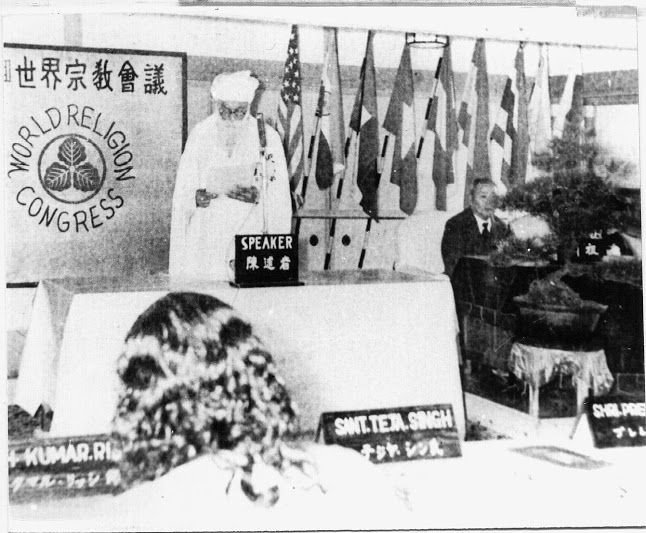
In his address, Sant Teja Singh Ji emphasized the imperative role of spiritual education for establishing permanent peace in the world. He said, " spirituality is as scientific, may be more exact in its realization than even the objective research called science. The whole material world is the manifestation of the Eternal Divine. In other words, the whole physical world is the physical frame of God. The scientific research deals with this frame. For long, science classified matter and spirit as two distinct things but now its ultimate research has found the truth."
Later, Sant Ji also served as principal of Teachers Training Institute of Banaras Hindu University, whose foundation stone was laid by Baba Ji. He founded Guru Nanak Khalsa College, Gujranwala, and with Baba Ji's blessings, he helped start Akal College, Mastuana.
Before the legislation of the Gurdwara Act of 1925 and during the formation of the Shiromani Gurdwara Parbhandak Committee (SGPC), Sant Teja Singh Ji served as Akal Takht Jathedar. He organized and conducted kaar seva of many Gurdwaras, wrote numerous books dealing with various aspects of Sikhi including the life story of Baba Attar Singh Ji Maharaj and his own candid autobiography.
Sant Teja Singh Ji regretted that the Sikh community, when cut off from true meanings of Gurbani, became self-destructive. On the problems faced by Sikhs and their inter-group conflicts, he was unequivocally clear that there was no chance of any outside interference in Sikh affairs. But due to lack of Nitnem practice, Sikhs became egocentric, and mutual bickering started increasing among them.
Sant Ji was very clear that in order to understand Gurbani, one has to attach his mind to Gurshabad with utmost vairaag and practice simaran wih devotion. He said that real answers come from within, as spirituality is not a domain of intellect.
Continuing Baba Ji's mission, in July 1957, Sant Teja Singh Ji revealed and visited the Tapo Bhoomi (meditative land) of Baru, where many Rishis, Munis and saints had meditated on the Divine Name for many yugas and which has also been blessed with the holy visit of the Tenth Nanak, Sri Guru Gobind Singh Ji Maharaj.
In 1959, Sant Teja Singh Ji, with a small and dedicated jatha of about 20 devotees, trekked more than 20 miles in the Himalayas to reach Baru Sahib. They set up a make shift camp and built a mud-hut, in which the first Sri Akhand Path of Sri Guru Granth Sahib Ji was initiated. At the successful completion of Sri Akhand Path Sahib, with teary eyes, Sant Teja Singh Ji performed an Ardas:
"True Master! When will you usher in the time when students from all over the world gather here and shape their lives in accordance with the teachings of Guru Nanak and bring peace to the world."
After the Ardaas, the surprised devotees told Sant Ji "There is no habitation and no roads around here. This jungle has only wild animals like monkeys and bears. Who will trek through the jungles to this remote spot?"
Sant Ji replied, "As a tiny banyan seed grows into a huge tree, in the same way this place will develop into a great center of spiritual education where high quality scientific education will also be imparted. In due course, roads will be built and all those whose hearts are brimful of love for Guru Nanak and who have toiled to accumulate spiritual capital from the previous births, will be drawn to this place."
His attachment to Gurbani was so intense that in Ardaas, when "Nanak Naam Chardi Kalan" was uttered, the whole world became non-existent for him, to such an extent that he would fall at the lotus feet of Sri Guru Granth Sahib Ji Maharaj, and would have to get up with the assistance of other sevadaars. Later, the sevadaars would have to assist Sant Ji in paying his respects to Maharaj Ji. Throughout his life, he had numerous divine visions of Sri Guru Maharaj Ji in all saroops at different occasions for different purposes.
Many of his prophetic utterings became truth in addition to healing and helping people in their worldly and spiritual affairs. He himself used to lead the devoted sangat in kirtan in a simple and humble manner.
[https://youtu.be/HoM_l1aaTxY]
Sant Teja Singh Ji established the Kalgidhar Trust, and blessed Baba Iqbal Singh Ji with the seva of transforming the young people through the synthesis of modern worldly education based on Sikh ideals. The activities of this Trust, based at Baba Attar Singh Hari Sadhu Ashram, Baru Sahib, Himachal Pradesh are being carried out as prophesized by Sant Teja Singh Ji, and the Trust is running many educational institutions and carrying out other social welfare activities.
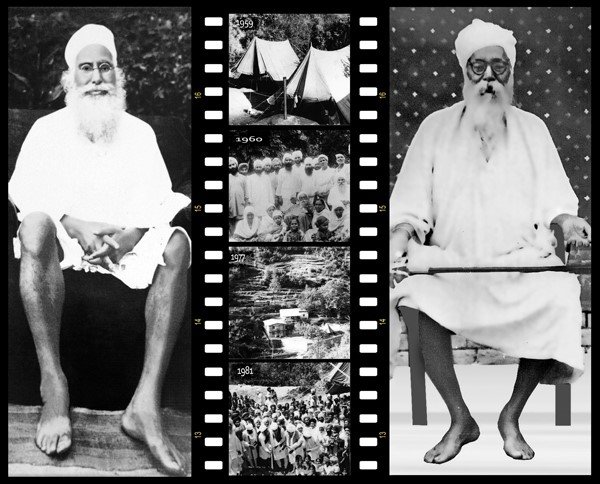
Sant Teja Singh Ji, with Sri Guru Nanak Dev Ji Maharaj Ji's blessings, completed his final journey from this world on July 3, 1965, and merged with the Lotus Feet of Sri Guru Maharaj Ji's eternal Divine Light.
Acknowledgments:
We would like to express our deep gratitude to Satguru Sache Patchah Ji Sri Guru Nanak Dev Ji Maharaj for blessing us with the successful completion of this seva. We also gratefully acknowledge and thanks all those whose audio, video, and documentary materials we have consulted in writing.




